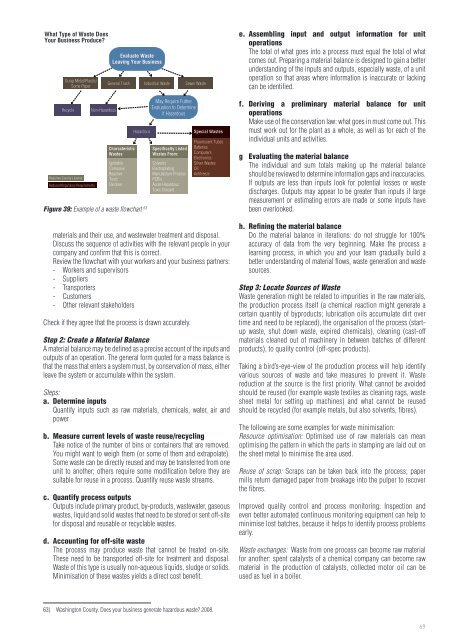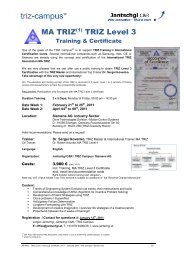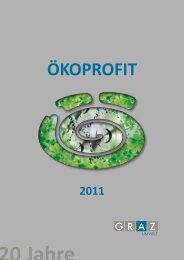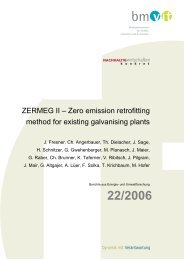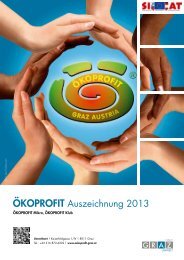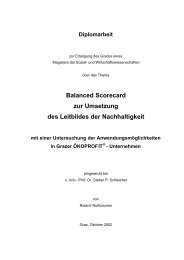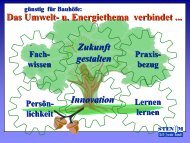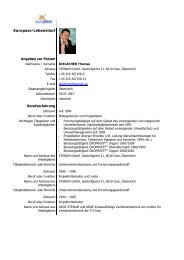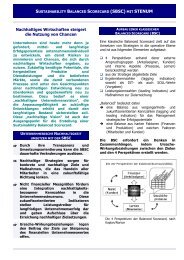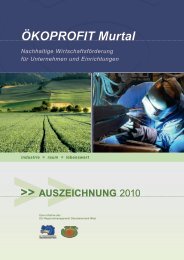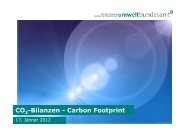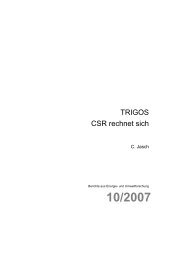Promoting Resource Efficiency in Small & Medium size ... - UNEP
Promoting Resource Efficiency in Small & Medium size ... - UNEP
Promoting Resource Efficiency in Small & Medium size ... - UNEP
You also want an ePaper? Increase the reach of your titles
YUMPU automatically turns print PDFs into web optimized ePapers that Google loves.
What Type of Waste Does<br />
Your Bus<strong>in</strong>ess Produce?<br />
Scrap Metal/Plastic/<br />
Some Paper<br />
Evaluate Waste<br />
Leav<strong>in</strong>g Your Bus<strong>in</strong>ess<br />
General Trash<br />
Industrial Waste<br />
Sewer Waste<br />
e. Assembl<strong>in</strong>g <strong>in</strong>put and output <strong>in</strong>formation for unit<br />
operations<br />
The total of what goes <strong>in</strong>to a process must equal the total of what<br />
comes out. Prepar<strong>in</strong>g a material balance is designed to ga<strong>in</strong> a better<br />
understand<strong>in</strong>g of the <strong>in</strong>puts and outputs, especially waste, of a unit<br />
operation so that areas where <strong>in</strong>formation is <strong>in</strong>accurate or lack<strong>in</strong>g<br />
can be identified.<br />
Recycle<br />
Requires County License<br />
Reduced Regulatory Requirements<br />
Non-Hazardous<br />
Characteristic<br />
Wastes<br />
Ignitable<br />
Corrosive<br />
Reactive<br />
Toxic<br />
Oxidiser<br />
Hazardous<br />
Figure 39: Example of a waste flowchart 63<br />
May Require Futher<br />
Evaluation to Determ<strong>in</strong>e<br />
if Hazardous<br />
Specifically Listed<br />
Wastes From:<br />
Solvents<br />
Electroplat<strong>in</strong>g<br />
Manufacture Process<br />
PCB’s<br />
Acute Hazardous<br />
Toxic Discard<br />
Special Wastes<br />
Fluorescent Tubes<br />
Batteries<br />
Computers<br />
Electronics<br />
Silver Wastes<br />
Oil<br />
Antifreeze<br />
materials and their use, and wastewater treatment and disposal.<br />
Discuss the sequence of activities with the relevant people <strong>in</strong> your<br />
company and confirm that this is correct.<br />
Review the flowchart with your workers and your bus<strong>in</strong>ess partners:<br />
- Workers and supervisors<br />
- Suppliers<br />
- Transporters<br />
- Customers<br />
- Other relevant stakeholders<br />
Check if they agree that the process is drawn accurately.<br />
Step 2: Create a Material Balance<br />
A material balance may be def<strong>in</strong>ed as a precise account of the <strong>in</strong>puts and<br />
outputs of an operation. The general form quoted for a mass balance is<br />
that the mass that enters a system must, by conservation of mass, either<br />
leave the system or accumulate with<strong>in</strong> the system.<br />
Steps:<br />
a. Determ<strong>in</strong>e <strong>in</strong>puts<br />
Quantify <strong>in</strong>puts such as raw materials, chemicals, water, air and<br />
power<br />
b. Measure current levels of waste reuse/recycl<strong>in</strong>g<br />
Take notice of the number of b<strong>in</strong>s or conta<strong>in</strong>ers that are removed.<br />
You might want to weigh them (or some of them and extrapolate).<br />
Some waste can be directly reused and may be transferred from one<br />
unit to another; others require some modification before they are<br />
suitable for reuse <strong>in</strong> a process. Quantify reuse waste streams.<br />
c. Quantify process outputs<br />
Outputs <strong>in</strong>clude primary product, by-products, wastewater, gaseous<br />
wastes, liquid and solid wastes that need to be stored or sent off-site<br />
for disposal and reusable or recyclable wastes.<br />
d. Account<strong>in</strong>g for off-site waste<br />
The process may produce waste that cannot be treated on-site.<br />
These need to be transported off-site for treatment and disposal.<br />
Waste of this type is usually non-aqueous liquids, sludge or solids.<br />
M<strong>in</strong>imisation of these wastes yields a direct cost benefit.<br />
f. Deriv<strong>in</strong>g a prelim<strong>in</strong>ary material balance for unit<br />
operations<br />
Make use of the conservation law: what goes <strong>in</strong> must come out. This<br />
must work out for the plant as a whole, as well as for each of the<br />
<strong>in</strong>dividual units and activities.<br />
g Evaluat<strong>in</strong>g the material balance<br />
The <strong>in</strong>dividual and sum totals mak<strong>in</strong>g up the material balance<br />
should be reviewed to determ<strong>in</strong>e <strong>in</strong>formation gaps and <strong>in</strong>accuracies.<br />
If outputs are less than <strong>in</strong>puts look for potential losses or waste<br />
discharges. Outputs may appear to be greater than <strong>in</strong>puts if large<br />
measurement or estimat<strong>in</strong>g errors are made or some <strong>in</strong>puts have<br />
been overlooked.<br />
h. Ref<strong>in</strong><strong>in</strong>g the material balance<br />
Do the material balance <strong>in</strong> iterations: do not struggle for 100%<br />
accuracy of data from the very beg<strong>in</strong>n<strong>in</strong>g. Make the process a<br />
learn<strong>in</strong>g process, <strong>in</strong> which you and your team gradually build a<br />
better understand<strong>in</strong>g of material flows, waste generation and waste<br />
sources.<br />
Step 3: Locate Sources of Waste<br />
Waste generation might be related to impurities <strong>in</strong> the raw materials,<br />
the production process itself (a chemical reaction might generate a<br />
certa<strong>in</strong> quantity of byproducts; lubrication oils accumulate dirt over<br />
time and need to be replaced), the organisation of the process (startup<br />
waste, shut down waste, expired chemicals), clean<strong>in</strong>g (cast-off<br />
materials cleaned out of mach<strong>in</strong>ery <strong>in</strong> between batches of different<br />
products), to quality control (off-spec products).<br />
Tak<strong>in</strong>g a bird’s-eye-view of the production process will help identify<br />
various sources of waste and take measures to prevent it. Waste<br />
reduction at the source is the first priority. What cannot be avoided<br />
should be reused (for example waste textiles as clean<strong>in</strong>g rags, waste<br />
sheet metal for sett<strong>in</strong>g up mach<strong>in</strong>es) and what cannot be reused<br />
should be recycled (for example metals, but also solvents, fibres).<br />
The follow<strong>in</strong>g are some examples for waste m<strong>in</strong>imisation:<br />
<strong>Resource</strong> optimisation: Optimised use of raw materials can mean<br />
optimis<strong>in</strong>g the pattern <strong>in</strong> which the parts <strong>in</strong> stamp<strong>in</strong>g are laid out on<br />
the sheet metal to m<strong>in</strong>imise the area used.<br />
Reuse of scrap: Scraps can be taken back <strong>in</strong>to the process; paper<br />
mills return damaged paper from breakage <strong>in</strong>to the pulper to recover<br />
the fibres.<br />
Improved quality control and process monitor<strong>in</strong>g: Inspection and<br />
even better automated cont<strong>in</strong>uous monitor<strong>in</strong>g equipment can help to<br />
m<strong>in</strong>imise lost batches, because it helps to identify process problems<br />
early.<br />
Waste exchanges: Waste from one process can become raw material<br />
for another: spent catalysts of a chemical company can become raw<br />
material <strong>in</strong> the production of catalysts, collected motor oil can be<br />
used as fuel <strong>in</strong> a boiler.<br />
63) Wash<strong>in</strong>gton County, Does your bus<strong>in</strong>ess generate hazardous waste? 2008.<br />
69


